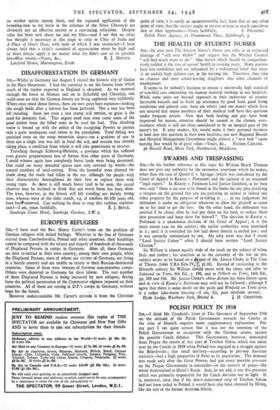DISAFFORESTATION IN GERMANY
Sm,—Whilst in Germany last August I visited the historic city of Goslar in the Harz Mountains. I had the curiosity to see the forests from which much of the timber exported to England is obtained. As we motored through the forest to Altenau and on to Zellerfeld and Clausthal, one could soon see that the German forests are being exploited very ruthlessly. Where once stood dense forests, there are now great bare expanses—looking like rough fields after a harvest has been gathered. Not a tree has been left standing. Soon not even a tree stump will remain, so great is the need for domestic fuel. This urgent need may even cause some of the good timber from the felled trees to be used for fuel. This shocking waste is bound up with the policy of the occupying Powers to permit only a quite inadequate coal ration to the population. Total felling was practised even on the steep mountain slopes—on a gradient of one in three not a single tree was left to bind the soil, and erosion was already taking place, a condition from which it will take generations to recover. Travelling through Schleswig-Holstein, a province which has suffered even greater proportionate loss of forests than other parts of Germany, I could witness again how completely forest lands were being destroyed. One could see many denuded spaces now only covered by weeds—the natural corollary of total-cutting. Even the beautiful trees planted for shade along the roads had fallen to the axe, although the people with their characteristic thoroughness do their best to replace them with young trees. As there is still much forest land to be seen, the casual observer may be inclined to think that not much harm has been done. The trees, however, in the forests still left standing are mainly young trees, whereas most of the older stands, e.g. of conifers 80-100 years old, have beerPremoved. Can nothing be done to stop this ruthless exploits-


































 Previous page
Previous page